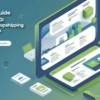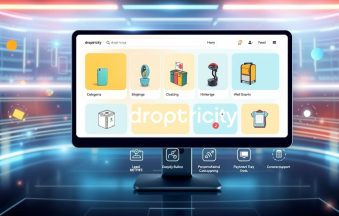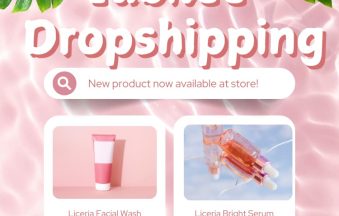So, you’re thinking about getting into dropshipping using Shopify, huh? That’s a smart move, especially looking ahead to 2025. This article is your straightforward guide, cutting through the noise to show you exactly how to build a successful online store without holding any inventory yourself. We’ll go over everything from picking the right products to getting customers to your site and keeping them happy. It’s all about setting you up for success in the world of dropshipping using Shopify.
Key Takeaways
Dropshipping on Shopify means you don’t need to buy products upfront, which saves you money and makes starting easier to start.
Finding the right products and good suppliers is a big deal for your store’s success.
Making your Shopify store look nice and easy to use helps people buy things from you.
Getting people to know about your store, whether through social media or ads, is how you get sales.
Good customer service, like handling returns smoothly, keeps customers happy and coming back.
Table of Contents
Understanding the Dropshipping Business Model

Defining Dropshipping for 2025
Okay, so what is drop shipping in 2025? It’s still about selling stuff online without actually holding any inventory yourself. Think of it as being the middleman but without the warehouse. You list products on your Shopify store, and when someone buys something, you forward the order to your supplier. They handle all the messy stuff like packing and shipping directly to customers. You never even see the product! It’s a pretty sweet deal if you don’t want to invest a ton of money upfront.
No inventory to manage
Lower startup costs
Flexibility to sell a wide range of products
Dropshipping is a business model where you don’t need a huge investment to start. It’s perfect for people who are good at marketing and want to run a store without dealing with inventory.
Profitability of Shopify Dropshipping
Can you make money with Shopify dropshipping? Absolutely, but it’s not a get-rich-quick scheme. It takes work. Your profit comes from the difference between what the customer pays you and what you pay the supplier, minus any advertising or operational costs. Finding the right niche and choosing a dropshipping niche is key. Also, remember that you’re competing with a lot of other stores, so you need to offer something unique, whether it’s better customer service, a curated product selection, or killer marketing.
Here’s a simplified look at how profitability works:
Item | Cost | Price | Profit |
|---|---|---|---|
Product Cost | $20 |
|
|
Shipping Cost | $5 |
|
|
Advertising | $3 |
|
|
Total Cost | $28 |
|
|
Selling Price |
| $45 |
|
Profit |
|
| $17 |
Key Advantages of Dropshipping Using Shopify
Shopify makes dropshipping pretty easy. One of the biggest advantages is the low barrier to entry. You don’t need a ton of capital to get started. Plus, Shopify has a ton of apps that can automate a lot of the processes, like order fulfillment and inventory management. You can also easily test different products and niches without committing to large inventory purchases. It’s a great way to learn about e-commerce and build a business without a huge amount of risk. Just remember to market your dropshipping business effectively!
Here are some advantages:
Easy to set up and manage your store.
Access to a wide range of apps for automation.
Ability to test different products and niches quickly.
Setting Up Your Shopify Store for Dropshipping
Okay, so you’re ready to jump into the world of dropshipping with Shopify? Awesome! This part is all about getting your digital storefront up and running. It might seem a little daunting at first, but trust me, it’s manageable. We’ll walk through picking your niche, building your store, and hooking up those essential dropshipping apps. Let’s get started!
Choosing Your Niche and Products
First things first: what are you going to sell? This is where you need to put on your thinking cap. Don’t just pick something random; think about what you’re interested in, what’s trending, and what problems you can solve for people. Finding the right niche is crucial for success.
Here’s a quick checklist:
Passion: Are you interested in this niche? It’ll make the work a lot more enjoyable.
Profitability: Is there a demand for these products, and can you make a decent profit margin?
Competition: Are there already a million other stores selling the same thing? Maybe look for something a little less saturated.
Remember, a well-defined niche helps you target your marketing efforts and build a loyal customer base. Don’t spread yourself too thin trying to be everything to everyone.
Building Your Online Storefront
Alright, now for the fun part: building your Shopify store! Shopify makes this surprisingly easy, even if you’re not a tech whiz. You can start with a free trial of Shopify to test the waters. Think of your storefront as your digital real estate. You want it to be clean, professional, and easy to navigate. Choose a theme that fits your brand and start customizing it. Don’t forget the important pages like:
Homepage: This is your first impression, so make it count!
Product Pages: High-quality images, detailed descriptions, and clear pricing are key.
About Us: Tell your story and build trust with your customers.
Contact Page: Make it easy for customers to reach you with questions or concerns.
Integrating Dropshipping Apps
This is where the magic happens. Dropshipping apps connect your Shopify store to suppliers, automating the process of fulfilling orders. There are tons of apps out there, but some of the most popular include Oberlo (though alternatives are becoming more common), Spocket, and DSers. These apps let you easily import products, set pricing rules, and automatically send orders to your suppliers. Make sure you design and sell popular products that integrate well with your chosen apps. Here’s what to look for in a dropshipping app:
Supplier Network: Does it connect you to reliable suppliers with quality products?
Automation: How much of the order fulfillment process is automated?
Pricing and Features: Does it fit your budget and offer the features you need?
App | Key Features | Pricing |
|---|---|---|
Spocket | US & EU Suppliers, Fast Shipping | Free plan available, paid plans from $24.99/month |
DSers | AliExpress Integration, Advanced Automation | Free plan available, paid plans from $19.90/month |
Once you’ve integrated your chosen app, you’re well on your way to running a successful dropshipping business on Shopify!
Sourcing Winning Products and Reliable Suppliers
Effective Product Research Strategies
Okay, so you’ve got your Shopify store ready to go. Now comes the fun part: finding stuff to sell! But not just any stuff. We’re talking about products that people want and will buy. Start by thinking about your niche. What are people searching for? What problems can you solve? Use tools like Google Trends to see what’s hot right now. Don’t just jump on the bandwagon of the latest fad, though. Think long-term. What has staying power?
Look at social media: What are people talking about? What are they sharing? What are they complaining about?
Check out competitor stores: What are they selling? What are their prices? What are their reviews like?
Browse online marketplaces: See what’s trending on Amazon, eBay, and Etsy. Pay attention to the number of listings and the level of competition.
Remember, the goal is to find products with high demand but low competition. That’s the sweet spot.
Identifying High-Demand Products
Finding high-demand products is like being a detective. You need to gather clues and analyze the evidence. Don’t just rely on gut feelings. Use data to back up your decisions. One thing I always do is check out eBay, Amazon, and Etsy. See what’s selling well in your niche. How many listings are there? Are the prices competitive? If the market looks saturated, think about how you can differentiate yourself. Can you offer a better price? A better product? A better customer experience? Also, keep an eye on reviews. What are people saying about the products? What are their pain points? This can give you valuable insights into what people are looking for.
Partnering with Top Dropshipping Suppliers
Your supplier is your lifeline in the dropshipping world. Choose wisely! A bad supplier can ruin your business faster than you can say “refund.” Look for suppliers with a proven track record of reliability, fast shipping, and quality products. Don’t be afraid to ask questions. A good supplier will be transparent and responsive. Check out supplier directories and apps to find potential partners.
Here’s what to look for in a good supplier:
Fast shipping: Customers expect their orders to arrive quickly. Look for suppliers with domestic fulfillment centers and partnerships with trusted carriers.
Reliable inventory: Frequent stockouts can lead to canceled orders and frustrated customers. Make sure your supplier has a good inventory management system.
Hassle-free returns: Returns are inevitable. Choose a supplier with a clear and easy-to-understand return policy.
Finding the right supplier is crucial for your dropshipping success. Don’t rush this step. Take your time and do your research. It’ll pay off in the long run.
Consider diversifying your suppliers. This is like having a safety net for your online shop. If one supplier has a problem, you’ll have other options to fall back on. This will help you keep your inventory fresh and exciting for your customers. Also, make sure you understand pricing strategies to maximize your profits.

Optimizing Your Shopify Store for Sales
Alright, so you’ve got your Shopify dropshipping store up and running. Now it’s time to make sure it’s selling stuff. It’s not enough to just have a pretty website; you need to optimize it to convert visitors into paying customers. Let’s get into the nitty-gritty.
Crafting Compelling Product Listings
Product listings are your sales pitch. They need to grab attention and convince people to buy. Think about it – this is often the first (and maybe only) interaction a potential customer has with your product. So, make it count!
Use high-quality images. Multiple angles are a must.
Write detailed, benefit-driven descriptions. Don’t just list features; explain how those features will improve the customer’s life.
Optimize for search. Use relevant keywords in your titles and descriptions so people can find your products. Think about what people are searching for when they’re looking for products like yours.
Automating Pricing and Fulfillment
Time is money, especially in dropshipping. Automating tasks frees you up to focus on marketing and growth.
Use apps to automatically adjust prices based on competitor pricing. This helps you stay competitive without constantly monitoring prices yourself. Consider price optimization strategies.
Set up automated order fulfillment with your dropshipping supplier. This means orders are automatically sent to your supplier when a customer places an order in your store.
Implement automated email marketing to follow up with customers after they make a purchase. This can include order confirmations, shipping updates, and thank-you notes.
Enhancing User Experience and Conversions
A smooth, easy-to-use website is key to increasing conversions. If your site is clunky or confusing, people will leave. It’s that simple. Think about the customer journey and make it as frictionless as possible.
Optimize your website’s loading speed. No one wants to wait around for a slow website. Use tools like Google PageSpeed Insights to identify and fix issues.
Make sure your website is mobile-friendly. A huge percentage of online shopping happens on mobile devices, so your site needs to look and function great on smartphones and tablets.
Simplify the checkout process. Reduce the number of steps required to complete a purchase. Offer multiple payment options to cater to different customer preferences.
Don’t be afraid to A/B test different elements of your store, like product descriptions, button colors, and checkout flows. Small changes can sometimes have a big impact on your conversion rate. Keep an eye on what’s selling well and what isn’t. Regularly check your analytics to see how trends in sales are changing over time. This will help you make informed decisions about your product offerings and marketing strategies.
Driving Traffic and Marketing Your Business

Okay, so you’ve got your Shopify dropshipping store all setup. Awesome! But now comes the part where you ask people to visit it and, you know, buy stuff. Marketing can feel overwhelming, but it’s just about getting your products in front of the right eyes. Let’s break down some ways to do that.
Leveraging Organic Social Media Marketing
Social media is more than just posting pretty pictures. It’s about building a community and connecting with potential customers. Think of it as a conversation, not a sales pitch.
Find out where your target audience hangs out. Are they on TikTok, Instagram, Facebook, or somewhere else?
Create content that’s interesting and useful to them. Tutorials, behind-the-scenes looks, or even just funny memes related to your niche can work.
Engage with your followers. Respond to comments, answer questions, and run polls to get them involved.
Don’t just post and ghost. Social media is about being social. If you’re not interacting with your audience, you’re missing out on a huge opportunity to build relationships and turn followers into customers.
Implementing Paid Advertising Campaigns
Alright, let’s talk about spending some money to make money. Paid advertising can be a quick way to get your products in front of a lot of people, but it’s important to do it strategically.
Start with a clear budget and target audience. Who are you trying to reach, and how much are you willing to spend to reach them?
Experiment with different ad platforms. Facebook, Instagram, Google Ads – they all have their strengths and weaknesses.
Track your results closely. Which ads are performing well, and which ones are duds? Don’t be afraid to tweak your campaigns based on the data.
Here’s a simple table to illustrate potential ad spend and return:
Platform | Ad Spend | Estimated Return | Notes |
|---|---|---|---|
$500 | $1500 | Good for broad targeting | |
Google Ads | $500 | $2000 | Better for specific product searches |
TikTok | $500 | $1000 | Great for visual and trending products |
Building a Strong Brand Presence
Branding is more than just a logo and a color scheme. It’s about creating a unique identity that resonates with your target audience. What makes your store different from all the others?
Define your brand values. What do you stand for? What’s your mission?
Create a consistent visual identity. Use the same colors, fonts, and imagery across all your marketing materials.
Tell your story. Why did you start this business? What are you passionate about? People connect with stories, not just products.
Managing Customer Service and Returns
Dropshipping means you don’t handle the products directly, but you handle the customers. Messing up customer service is a quick way to kill your business, even if your products are great. Returns are just part of the game, so you need a solid plan for dealing with them.
Providing Exceptional Customer Support
Good customer support can turn a one-time buyer into a loyal fan. Make it easy for customers to contact you – think email, chat, maybe even a phone number if you’re feeling ambitious. Respond quickly and be helpful, even when customers are frustrated. Remember, you’re the face of their purchase, so be friendly and professional.
Offer multiple contact channels (email, chat, phone).
Respond promptly to inquiries (aim for within 24 hours).
Be empathetic and solution-oriented in your responses.
Streamlining Return and Refund Processes
Returns happen. Don’t fight it. Make the process as smooth as possible for the customer. A clear, easy-to-understand return policy builds trust. Offer options like exchanges or store credit to keep the sale. Work with your suppliers to understand their return policies, so you’re not stuck with the bill.
A hassle-free return process can actually increase customer loyalty. People are more likely to buy from you again if they know they can easily return something if it doesn’t work out.
Create a clear and concise return policy.
Offer multiple return options (e.g., prepaid labels, in-store returns).
Process refunds quickly and efficiently.
Utilizing AI Tools for Customer Interactions
AI isn’t just a buzzword; it can seriously help with customer service. Chatbots can answer common questions 24/7, freeing up your time for more complex issues. AI can also help personalize customer interactions and predict their needs. It’s not about replacing human interaction entirely, but about making it more efficient and effective.
Implement chatbots for basic inquiries and support.
Use AI to personalize customer interactions and product recommendations.
Analyze customer data to identify areas for improvement in service and product offerings.

Scaling Your Dropshipping Business on Shopify
So, you’ve got your Shopify dropshipping store up and running. Sales are trickling in, and you’re feeling pretty good. But how do you take it to the next level? How do you go from a side hustle to a serious income stream? That’s where scaling comes in. It’s not just about doing more of the same; it’s about making smart, strategic moves to grow your business efficiently and sustainably.
Analyzing Performance and Metrics
First things first, you need to know where you stand. Data is your best friend when it comes to scaling. Don’t just guess what’s working; look at the numbers. Check your Shopify dashboard regularly. What’s your conversion rate? What’s your average order value? What are your best-selling products? Understanding these metrics will help you identify areas for improvement and opportunities for growth. Keep an eye on your business’s performance to make data-driven adjustments when necessary.
Here are some key metrics to track:
Conversion Rate: Percentage of visitors who make a purchase.
Average Order Value (AOV): The average amount spent per order.
Customer Acquisition Cost (CAC): How much it costs to acquire a new customer.
Customer Lifetime Value (CLTV): The total revenue you expect to generate from a single customer over their relationship with your business.
Analyzing these metrics isn’t just about looking at numbers; it’s about understanding the story they tell about your business. Are people browsing but not buying? Maybe your product descriptions need work. Is your AOV low? Consider bundling products or offering discounts for larger orders.
Expanding Product Offerings
Once you have a handle on your current performance, think about expanding your product line. Don’t just add random stuff; be strategic. Look at what’s already selling well and find complementary products. For example, if you’re selling phone cases, maybe add screen protectors or charging cables. You could also survey your existing customers to see what else they’d be interested in buying from you. Consider designing and selling popular Shopify products to help your business skyrocket in popularity and scale in profitability.
Here are some ways to expand your product offerings:
Introduce product bundles.
Add variations of existing products (different colors, sizes, etc.).
Explore new product categories that complement your current offerings.
Achieving Long-Term Growth and Profitability
Scaling isn’t just about making more money now; it’s about building a sustainable business for the future. That means focusing on things like customer retention, brand building, and operational efficiency. Think about ways to keep your customers coming back for more. Implement a loyalty program, offer personalized recommendations, and provide exceptional customer service. Also, look for ways to automate tasks and streamline your processes to save time and money. An effective marketing strategy is key to scaling your Shopify dropshipping stores.
Here are some strategies for long-term growth:
Build an email list and use email marketing to stay in touch with customers.
Create engaging content (blog posts, videos, social media posts) to attract new customers and build brand awareness.
Automate tasks like order fulfillment and customer support using apps and tools.
Wrapping Things Up
So, there you have it. Getting into dropshipping with Shopify in 2025 isn’t as scary as it might seem. We’ve gone over the basics, talked about finding good products, and even touched on how to get people to buy from you. It’s a pretty straightforward path if you stick with it. Just remember, it takes some effort and a bit of learning along the way. But with Shopify making things so simple, you’ve got a solid platform to build something cool. Give it a shot, see what happens. You might just surprise yourself.
Frequently Asked Questions
What exactly is dropshipping?
Dropshipping is a business where you sell products online without actually keeping them in stock. When a customer buys something from your store, you then buy it from a supplier, and they ship it directly to the customer. You never touch the product yourself. It’s a great way to start an online store with less money upfront, as you don’t need to buy a bunch of stuff to fill a warehouse.
Why should I use Shopify for dropshipping?
Shopify is a fantastic platform for dropshipping because it’s super easy to use, even if you’re new to selling online. It has tons of tools to help you set up your store, manage orders, and connect with suppliers. Plus, there are many apps that make dropshipping even simpler, like finding products and handling shipping. It’s built to help you succeed in online sales.
How do I pick the best products to sell?
Finding the right products is key! You want to look for things that people are excited about and that solve a problem for them. Think about what’s trending, but also what has lasting appeal. Tools that show you what’s popular online can be a big help. Once you find a good product, make sure it’s something you can sell for a decent profit after all the costs.
Is Shopify dropshipping truly profitable?
Yes, you can make good money with Shopify dropshipping, but it’s not a get-rich-quick scheme. It takes hard work and smart choices. Your profits depend on what you sell, how well you market your store, and how good you are at keeping your costs down. Many people find it to be a very profitable way to run an online business.
How can I get more customers to my Shopify dropshipping store?
Getting people to visit your store is super important. You can use social media like TikTok or Instagram to show off your products and create fun videos. Also, running paid ads on platforms like Facebook or Google can get your store in front of many potential customers. The goal is to get as many eyes on your products as possible.
What’s the best way to handle customer service and returns?
Dealing with customer questions and returns is a big part of running any business. Make sure you have clear rules for returns and refunds, and respond quickly to any messages from customers. Being helpful and friendly builds trust. You can even use smart computer programs (AI) to help answer common questions, so you can focus on bigger tasks.










Add comment